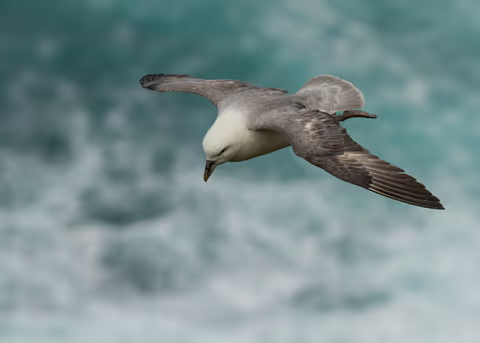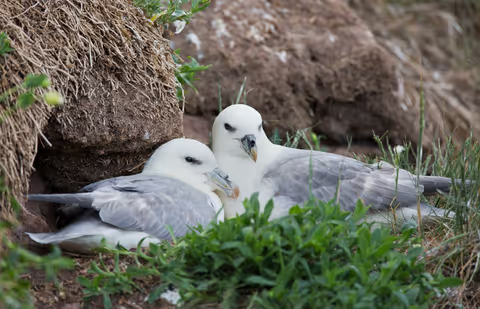The Northern Fulmar: A Bird of the Sea



The Northern Fulmar (scientific name: Fulmarus glacialis) is not the easiest bird to spot. That is because it prefers to spend its time in open oceans and some inland waterways. Your odds of seeing one on land are not zero, but they aren't very high either. Northern Fulmars are quite abundant in the cold, deep waters of the northern Pacific, Arctic, and Atlantic Oceans in which they feed. They have a strong sense of smell, which enables them to detect and apprehend their prey. While they spend most of the year in the open ocean, Northern Fulmars make their way to steep cliffs once a year for their annual breeding season.
Migration
Like many bird species, Northern Fulmars are migratory birds. This means that they don't spend the entire year in one location. Instead, they travel between winter homes and breeding season homes. In the winter months, they live in a wide swath of the Pacific Ocean, ranging from Alaska to approximately the middle of Baja California. They also live in the Atlantic Ocean, ranging from Labrador (Canada) to Virginia. During the breeding season, they live in the waters off the coast of Alaska, as well as in the waters of far Northern Canada, Newfoundland and Nova Scotia. Additionally, Northern Fulmars can also be found in the waters off the coasts of the United Kingdom and Iceland.
Patterns and Subspecies
All Northern Fulmars are patterned similarly to gulls. They are medium-sized seabirds with stout bodies, large heads, long wings, and short necks. Most Northern Fulmars are "light morph" (3). This means that they are white below and gray on top. "Light morph" fulmars are the most common fulmars in the Atlantic Ocean, and are officially recognized by ornithologists as a subspecies of the Northern Fulmar that is known as the large-billed F g. auduboni. "Dark morph" (3) Northern Fulmars are gray all over, with shades ranging from pale to dark. These are the most common fulmars in the Arctic Ocean and northern Pacific Ocean, where ornithologists officially recognize them as a second subspecies of the Northern Fulmar known as F. g. glacialis. Most of the Pacific Ocean has a wide array of Northern Fulmars with both light and dark morphs. However, the fulmars in the Pacific tend to have more slender bills. Ornithologists have, therefore, classified them as being a third subspecies of the Northern Fulmar, known as F. g. rodgersii.

Size
Both male and female Northern Fulmars are 15.3 to 19.7 inches (39 to 50 centimeters) long. They have a wingspan of 39.4 to 44.1 inches (100 to 112 centimeters), and weigh anywhere from 15.9 to 35.3 ounces (450 to 1,000 grams). Members of the F. g. rodgersii subspecies tend to be intermediate in size, with length, wingspans, and weight all typically being closer to the middle of the ranges noted above.
Flying and Feeding
Northern Fulmars fly at high speeds with stiff-winged glides and fast wingbeats. They wheel in strong winds without no effort, often swinging up in tall arcs over ocean waves. When feeding, they plunge into the water and dive below the surface to depths of at least twelve feet. They are able to do this by means of the propulsion power that is provided by their feet and wings, which are only open to half of their normal wingspan during this maneuver. When they don't want to fly, Northern Fulmars forage for food by grabbing items that are either at or just beneath the surface of the water while swimming. Feeding can occur at any time of the day or night.
The Northern Fulmar's diet is unusually large when compared to other bird species. Squid, crustaceans, and fish are all on the menu, as well as marine worms and carrion. They like to follow fishing boats and other ships and eat scraps, refuse, and offal that are discharged from the vessels. In the northern Pacific Ocean, jellyfish are also part of the Northern Fulmar's eating regimen. Foraging is commonly done in large flocks. Sometimes, the flocks only contain Northern Fulmars. At other times, other seabird species are included. Occasionally, marine mammals even get in on the act.
Breeding and Nesting
Northern Fulmars breed for the first time at six to twelve years of age. They breed in colonies, which are usually very dense. At nesting sites, they display in an array of situations by opening their bills wide, and waving their heads around while calling. Mated pairs nibble at each other's bills and heads. Nests are built either on the ledges of cliffs or hollows in banks or slopes. While nests are not built on rock ledges, pebbles are sometimes added as lining.
Northern Fulmars only lay one egg per breeding season. The egg is white in color. The incubation process is handled by both parents, and runs for approximately fifty days. When the young hatch, both parents turn their attention toward feeding their newborn bird through the regurgitation process. One of the parents is almost always on hand at the nest for the young's first two weeks of life. When the parents aren't there, the young are not entirely unprotected, as they are able to defend themselves by spitting an odoriferous oil (adult Northern Fulmars can also spit this oil to defend themselves, should they need to). The young make their first flights anywhere from 41 to 57 days after hatching. The Northern Fulmar is one of the world's longest living birds, with adults typically making it into their thirties.
References
1. https://www.audubon.org/field-guide/bird/northern-fulmar
2. https://www.allaboutbirds.org/guide/Northern_Fulmar/overview
3. https://www.allaboutbirds.org/guide/Northern_Fulmar/id
© Ian D. Caldwell, February 2022
Touch whale bones, examine shipwreck artifacts and connect with the coast's living history.

Support our mission, get involved in educational programs, or contribute through donations and volunteering.